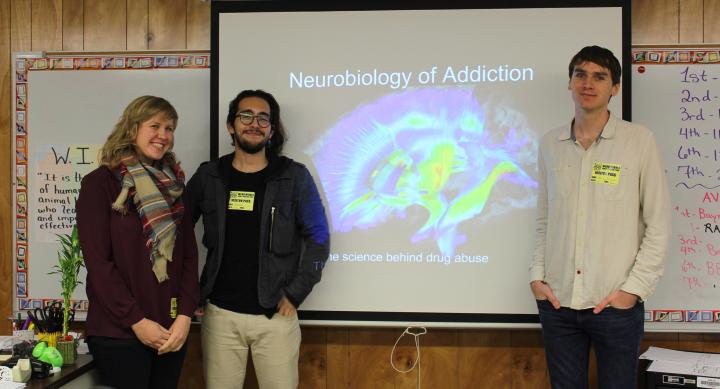
Three Waggoner Center graduate students are going “back to school” with a drug education outreach program for local middle- and high-school students.
Roberto Cofresí (Gonzales Lab), Adam Gordon (Marinelli Lab) and Anna Warden (Harris Lab), with help from teachers Janaye Pierce, Ricki Harrell and Ati Wongsaroj at Webb Middle School, and Jon Smith and Jane Smythe from Travis High School, developed an interactive lesson that’s integrated into a science class unit.
The lesson “engages teens and pre-teens on the issue of addiction and other health risks associated with alcohol and drug use including unique risks in adolescence,” said Confresí. He and his colleagues hope that “education provided around the time drug use is often initiated will empower adolescents to make healthier alcohol and drug use-related choices including minimizing use or delaying use until adulthood.”
In contrast to previous failed drug outreach programs in public schools that employed scare tactics, this neuroscience program uses a harm reduction strategy, where students are presented with scientific evidence of drug-induced effects that lead to addictive behaviors. Students also learn about the environmental and genetic factors that contribute to drug addiction, including early onset exposure and how this can affect the developing adolescent brain. Students are introduced to the concept of drug-induced neuroadaptations and gain an understanding of how repeated drug use can specifically target the function of brain cells.
The interactive presentation generates lots of questions from students. "What's interesting is that every classroom is different, students ask questions ranging from basic ones about myths surrounding marijuana to questions about bath salts and other drugs they've never heard about," said Warden. "Adam and Roberto have even been in classrooms that discuss the anthropological origins of drug use. Typically, students ask personal questions such as 'my mom smokes a lot and she doesn't think it's addictive, how do I tell her that it is?' Students also ask us about drug safety, for instance with naloxone for opiate overdose. We do tend to get a lot of questions about drug legality (i.e. why is this drug legal but you say it's dangerous). This is a point we like to focus on, just because it's legal doesn't mean it's safe. We emphasize that thinking about the mechanism of action of the drug and the short/long term consequences is a better way to gauge if you should take a drug."
To date, 385 students from the two schools have participated in the program. About 76 percent of these students are considered to be at-risk, meaning they face a higher probability of poor academic performance or drop-out rates. More than 85 percent are economically disadvantaged. The outreach program was designed specifically for this community, since the potenial for harm from drug use and need for resources is greater.

